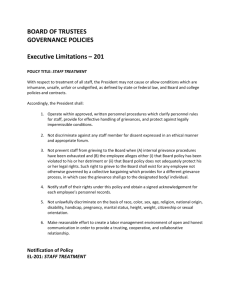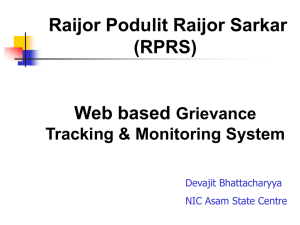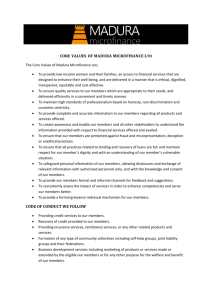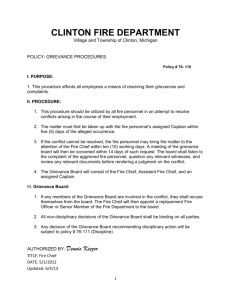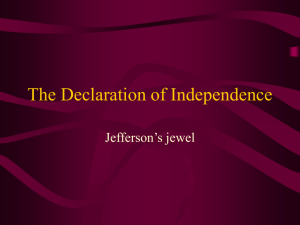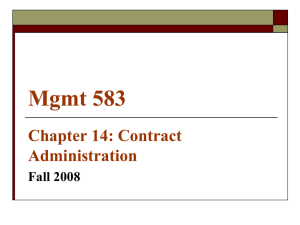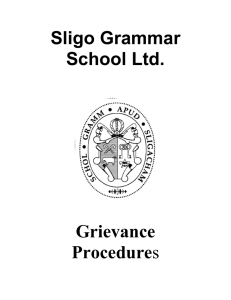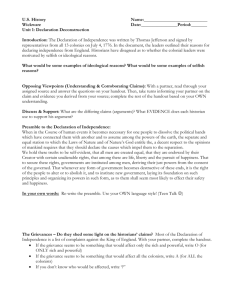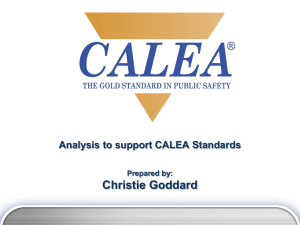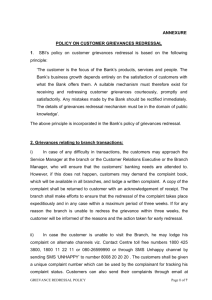SGB for Human Resource Management and Practices
advertisement
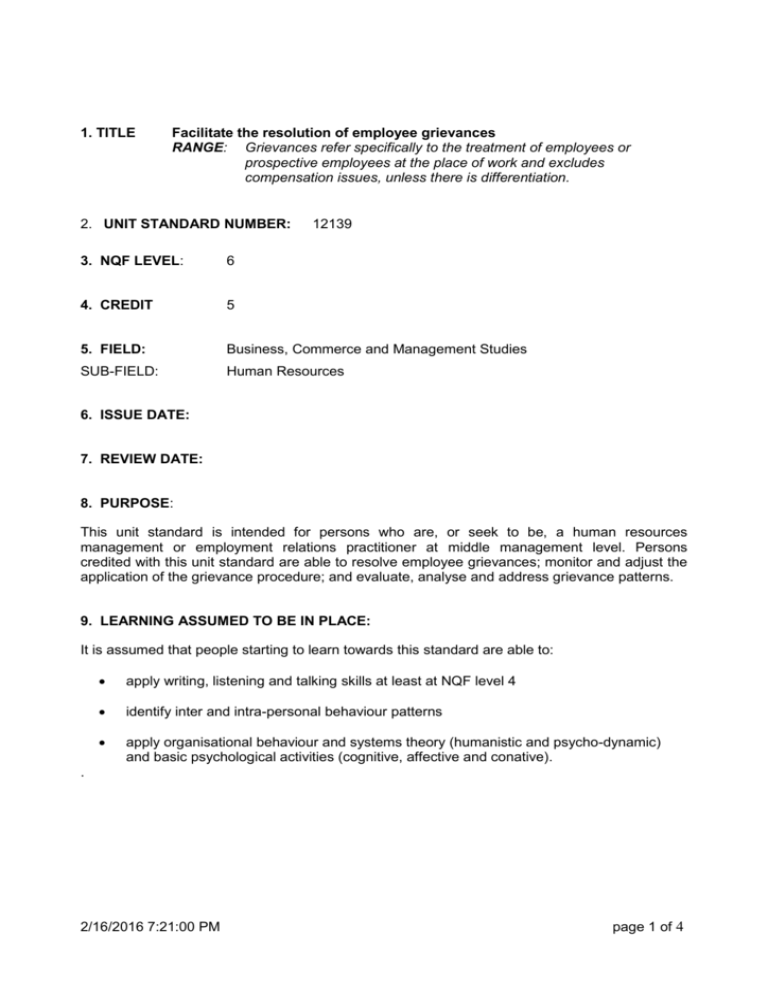
1. TITLE Facilitate the resolution of employee grievances RANGE: Grievances refer specifically to the treatment of employees or prospective employees at the place of work and excludes compensation issues, unless there is differentiation. 2. UNIT STANDARD NUMBER: 12139 3. NQF LEVEL: 6 4. CREDIT 5 5. FIELD: Business, Commerce and Management Studies SUB-FIELD: Human Resources 6. ISSUE DATE: 7. REVIEW DATE: 8. PURPOSE: This unit standard is intended for persons who are, or seek to be, a human resources management or employment relations practitioner at middle management level. Persons credited with this unit standard are able to resolve employee grievances; monitor and adjust the application of the grievance procedure; and evaluate, analyse and address grievance patterns. 9. LEARNING ASSUMED TO BE IN PLACE: It is assumed that people starting to learn towards this standard are able to: apply writing, listening and talking skills at least at NQF level 4 identify inter and intra-personal behaviour patterns apply organisational behaviour and systems theory (humanistic and psycho-dynamic) and basic psychological activities (cognitive, affective and conative). . 2/16/2016 7:21:00 PM page 1 of 4 10. SPECIFIC OUTCOMES AND ASSESSMENT CRITERIA: Specific Outcome 1: Develop structures and procedures to resolve employee grievances. Assessment Criteria 1.1 Structures and procedures are appropriate to resolve employee grievances. RANGE: Types of grievances include general grievances related to treatment at the workplace, grievances related to sexual harassment and grievances related to discrimination and equity. Compensation issues are excluded unless there is differentiation. 1.2 All relevant stakeholders within the workplace are consulted and encouraged to contribute. 1.3 The structures and procedures comply with all legal requirements and codes of good practice. 1.4 Provision is made for reasonable and practical time frames. 1.5 Procedures are sufficiently comprehensive, easily accessible and applicable to all categories of employees. 1.6 Structures and procedures are formalised. Specific Outcome 2: Implement structures and procedures to resolve employee grievances. Assessment Criteria 2.1 All stakeholders are advised through appropriate media of the structures and procedures. 2.2 Commitment and support is obtained from relevant stakeholders. 2.3 All relevant stakeholders are provided with appropriate training in the use of structures and procedures. 2.4 Appropriate assistance and advice on the use of structures and procedures are given to all relevant stakeholders to ensure adherence to the agreed grievance procedures adherence to specified timeframes correctly formulated grievances resolution at the lowest possible managerial level. 2/16/2016 7:21:00 PM page 2 of 4 Specific Outcome 3: Monitor the application of the grievance procedures and adjust when required. . Assessment Criteria 3.1 Problems in the application of the procedures are correctly identified when they occur. 3.2 Procedures are regularly checked against legal requirements and codes of good practice. 3.3 Corrective interventions are identified and implemented. 3.4 All relevant stakeholders are immediately informed when amendments to the grievance procedures have been agreed to. Specific Outcome 4: Evaluate, analyse and address grievance patterns. . Assessment Criteria 4.1 An appropriate and user-friendly recording system is implemented and maintained. 4.2 Grievance patterns are correctly identified and analysed at regular intervals. 4.3 The necessary corrective and preventive actions are identified and implemented. 11. ACCREDITATION AND MODERATION: 1. Anyone assessing a learner against this unit standard must be registered as an assessor with the relevant ETQA. 2. Any institution offering learning that will enable achievement of this unit standard or will assess this unit standard must be accredited as a provider with the relevant ETQA. 3. Moderation of assessment will be overseen by the relevant ETQA according to the moderation guidelines in the relevant qualification and the agreed ETQA procedures. 4. Therefore, anyone wishing to be assessed against this unit standard may apply to be assessed by any assessment agency, assessor or provider institution that is accredited by the relevant ETQA. 12. NOTES: Embedded Knowledge Knowledge considered to be critical evidence of competence is included in the assessment criteria explicitly, or can be inferred by performance. This includes knowledge on Applying the principles of fairness to a grievance process in hierarchical and other organisations Recording and analysis of grievances. 2/16/2016 7:21:00 PM page 3 of 4 Critical Cross-field Outcomes The following examples illustrate some of the ways in which this unit standard supports critical cross-field outcomes: 1. Identify and solve problems by using critical and creative thinking by, e.g., identifying corrective and preventive actions to address identified application problems and grievance patterns (assessment criteria 3.3 and 4.3). 2. Organise and manage oneself and one’s activities by, e.g. planning and implementing a monitoring process according to assessment criteria 3.1 to 3.4. 3. Collect, analyse, organise and critically evaluate information by, e.g., obtaining stakeholder input and identifying legal requirements when designing structures and procedures (assessment criteria 1.2 and 1.3). 4. Communicate effectively by, e.g., advising stakeholders through appropriate media of the structures and procedures (criterion 2.1). providing stakeholders with appropriate training in the use of structures and procedures (assessment criterion 2.3). 5. Demonstrate an understanding of the world as a set of related systems by, e.g. evaluating, analysing and addressing grievance patterns according to assessment criteria 4.1 to 4. Role cluster The SGB: Human Resources Management and Practices has grouped unit standards into four role clusters in its document “A Framework for Qualifications for Professionals and Practitioners in People Management Processes”. This unit standard falls into the following cluster: ESTABLISH AND MAINTAIN LABOUR AND EMPLOYEE RELATIONS 2/16/2016 7:21:00 PM page 4 of 4
